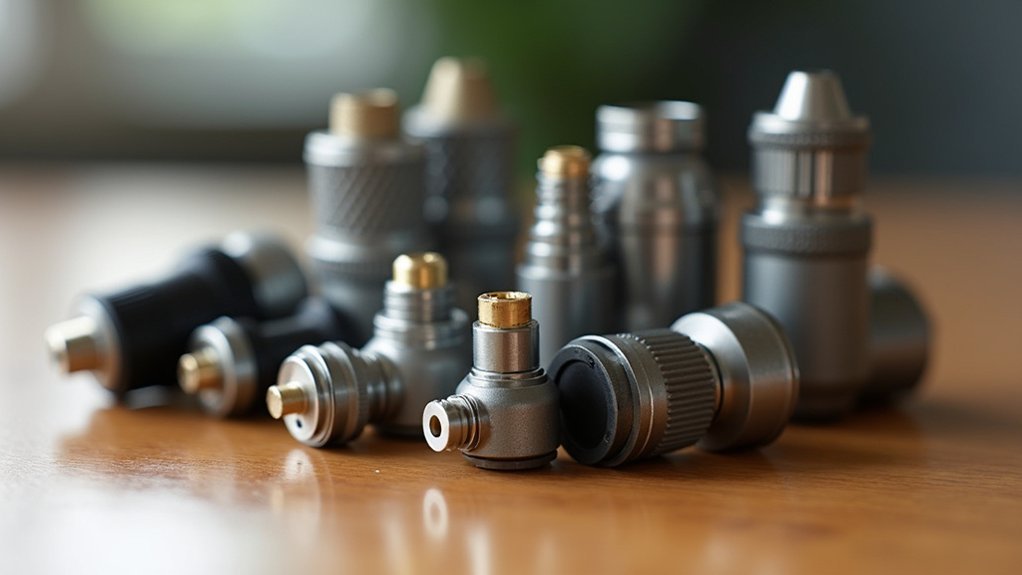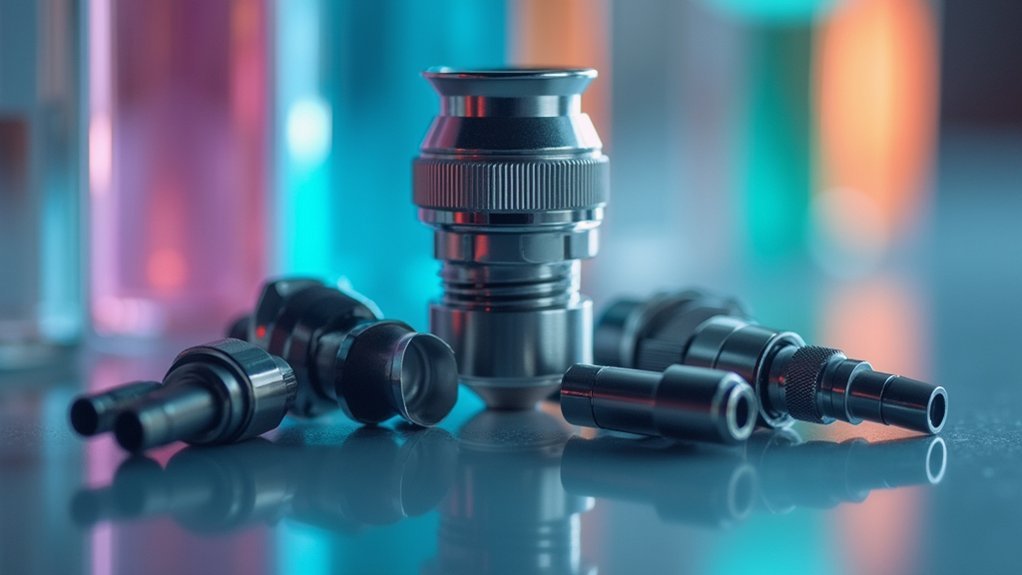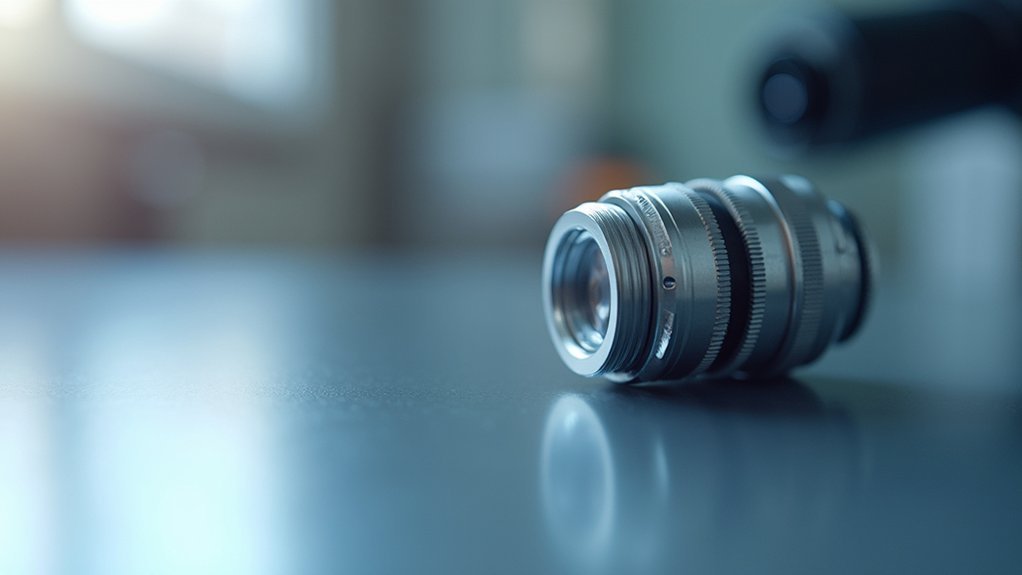Choosing the right microscope adapter requires matching your camera’s sensor size with the appropriate de-magnification factor. For ideal results, select C-Mount adapters (25.5mm thread) for microscopy over T-Mount (42mm) options. Your camera type matters too—DSLRs need different setups than smartphones. Consider material quality and durability, as premium constructions deliver better image clarity without vignetting. The perfect adapter creates a parfocal system that’ll transform your microscopy experience with crisp, professional imagery.
Microscope Adapter Specs: Find Your Perfect Match

The right C-Mount adapter serves as the critical bridge between your microscope and camera, guaranteeing excellent imaging quality and functionality. These adapters typically feature a standard 25.5mm male thread that connects seamlessly with most microscope cameras.
The C-Mount adapter creates an essential connection, ensuring optimal imaging through its standardized 25.5mm thread design.
When selecting your adapter, you’ll need to take into account your specific microscope brand, as dedicated options exist for Leica, Zeiss, Nikon, and Olympus. Pay close attention to the magnification factor, which must align with your camera’s sensor size and eyepiece magnification.
For instance, a 1/2″ sensor with a 10x eyepiece requires a 0.5x adapter.
Many C-Mount adapters include internal optics that properly align your camera’s field of view with the microscope’s, preventing vignetting and maintaining image quality. Proper selection guarantees both instruments remain parfocal, delivering crisp, clear imaging.
Understanding C-Mount vs. T-Mount Adapter Types
When choosing between C-Mount and T-Mount adapters, you’ll notice fundamental differences in their optical compatibility and thread specifications.
C-Mount adapters feature a standard 25.5mm male thread with built-in optics that accommodate your camera’s sensor size to match microscope eyepiece magnification.
T-Mount systems offer greater versatility across camera brands through their universal threading, but they typically lack the internal optics that prevent vignetting in specialized microscope applications.
Optical Compatibility Differences
Although both adapter types connect cameras to optical instruments, C-Mount and T-Mount adapters differ greatly in their optical compatibility and performance characteristics. C-Mount adaptors are specifically engineered for microscopy with their 25.5mm threads and built-in optics that match your camera’s sensor size to the microscope’s magnification.
When choosing between these options, you’ll need to evaluate how each affects image quality and functionality:
| Feature | C-Mount | T-Mount |
|---|---|---|
| Parfocal Setup | Yes – maintains focus | No – may require refocusing |
| Internal Optics | Present – adjusts magnification | Absent – direct connection |
| Field of View | Full circular image | Potential vignetting |
The C-Mount’s specialized design enables better microscope integration, preserving focus while you adjust eyepieces and delivering superior field coverage compared to the more universal but optically limited T-Mount system.
Camera Sensor Size Impact
Because your camera’s sensor size directly affects image quality and field of view, selecting the appropriate adapter becomes critical for successful microscopy imaging.
C-Mount adapters require specific de-magnification factors based on your camera sensor size to match your microscope’s eyepiece magnification. For example, if you’re using a 1/2″ sensor with a 10x eyepiece, you’ll need a 0.5x C-Mount adapter, while a 20x eyepiece would require a 0.7x adapter.
Larger sensors typically work better with C-Mount adapters, while smaller sensors may function adequately with simpler T-Mount setups.
Incorrect pairing can result in vignetting—dark corners appearing in your images where the circular microscope view doesn’t fully cover your rectangular sensor. Always verify compatibility between your camera sensor size and adapter type to guarantee superior image quality.
Thread Specification Variances
The technical specifications of adapter threads greatly impact your microscopy imaging results. When selecting between adapter types, you’ll encounter two main standards: C-Mount adaptors with 25.5mm male threads and T-Mount adaptors with 42mm male threads.
C-Mount adaptors are specifically designed for microscopy applications, offering parfocal alignment that guarantees simultaneous focus between your microscope and camera. They’re compatible with most digital cameras and trinocular microscope ports, making them the industry standard for microscope imaging.
In contrast, T-Mount systems are primarily used in astrophotography and telescope connections. They typically require additional components for proper focal adjustment, unlike the more microscope-ready C-Mount design.
Understanding these differences is vital—choosing the wrong thread specification can compromise image quality and prevent proper device compatibility in your imaging setup.
Camera Sensor Size Compatibility Considerations
When selecting a microscope adapter, your camera’s sensor size will determine the ideal magnification factor needed for proper image capture.
You’ll need to match larger sensors like 2/3″ or 1″ with appropriate adapters (typically 0.5x to 0.7x) to prevent vignetting while maintaining adequate field coverage.
This careful pairing guarantees you’re capturing the maximum viewable area without compromising image quality or introducing dark corners in your microscopy images.
Sensor Size Affects Magnification
Camera sensor dimensions play an essential role in determining the appropriate magnification factor for your microscope adapter.
When selecting a C-mount adapter, you’ll need to match its de-magnification ratio to your camera’s sensor size to prevent vignetting and maintain image quality.
For example, if you’re using a 1/2″ sensor with a 10x eyepiece, you’ll typically need a 0.5x adapter.
Smaller 1/3″ sensors require lower magnification adapters, while larger sensors may need higher magnification—though this could narrow your field of view.
To calculate the ideal de-magnification ratio, divide the front number of the adapter by your sensor size.
This guarantees your camera’s field of view aligns perfectly with your microscope, maintaining parfocality across different magnifications.
Field Coverage Trade-offs
Selecting the right adapter involves critical field coverage trade-offs that balance magnification with viewable area.
Your camera’s sensor shape greatly impacts what you’ll see through your microscope adapter. Rectangular sensors often produce vignetting (dark corners) when paired with circular microscope images.
For best results, match your sensor size to the appropriate C-Mount adapter. A 1/2″ sensor typically works best with a 0.5x adapter to maintain proper magnification without sacrificing field coverage. If you’re using a 10x eyepiece, this 0.5x ratio helps preserve the full field of view.
While higher magnification adapters can reveal more detail, they reduce overall viewable area.
Always verify your adapter diameter matches your trinocular port size to avoid focal issues and image quality problems.
Magnification Factors and Field of View

Understanding the relationship between magnification factors and field of view is essential for achieving ideal microscope imaging results. The magnification factor of your C-Mount adaptor must be calculated based on your camera sensor size and eyepiece magnification.
| Sensor Size | Eyepiece Mag | Recommended Adaptor | Field of View | Vignetting Risk |
|---|---|---|---|---|
| 1/2″ | 10x | 0.5x | Standard | Low |
| 1/2″ | 20x | 0.7x | Narrower | Medium |
| 1/3″ | 10x | 0.35x | Wider | Very Low |
| 2/3″ | 10x | 0.6x | Limited | High |
| 1″ | 20x | 1.0x | Very limited | Very High |
Selecting the wrong adaptor may result in dark corners where the circular microscope image doesn’t fully cover your rectangular sensor. You’ll need to balance your desired field of view against potential vignetting effects to guarantee your camera remains parfocal with the microscope.
Thread Specifications and Physical Dimensions
When selecting a microscope adapter, you’ll need to match the thread specifications to your equipment, with C-Mount’s 25.5mm male thread being the industry standard.
Diameter sizing varies greatly between models, with options available for eyepieces up to 1.5 inches in outside diameter and multiple mounting sizes like 23.2mm, 30mm, and 30.5mm to accommodate different microscope brands.
The adapter’s length directly impacts your magnification factor and field of view, so you should consider both your imaging requirements and physical space constraints when making your selection.
Standard Thread Patterns
The success of your microscope adapter setup depends largely on matching the correct thread patterns and physical dimensions.
When selecting a camera adapter, you’ll need to identify both the microscope’s port size and your camera’s threading requirements.
The industry standard C-Mount features 25.5mm male threads, providing wide compatibility with microscopy cameras and optical systems.
However, eyepiece adapters come in various sizes:
- 23.2mm threading for standard student microscopes
- 30mm threading for many research-grade optical systems
- 30.5mm threading for specialized equipment from certain manufacturers
- Variable adapter lengths that affect focal distance and image quality
Remember that adapter length impacts the distance between your camera sensor and microscope optics.
For brand-specific microscopes, you’ll often need custom adapters designed to match their proprietary specifications for ideal imaging results.
Diameter Sizing Guide
Selecting the correct diameter for your microscope adapter directly impacts image quality and system functionality.
When shopping for C-Mount adapters, note that most feature a standard 25.5mm male thread, ensuring broad camera compatibility.
Your microscope’s trinocular port dictates the adapter size you’ll need. Common mounting diameters include 23.2mm, 30mm, and 30.5mm.
Precise matching between your adapter and microscope port prevents focusing issues and potential vignetting.
Physical dimensions vary between models—for example, the AmScope CA-NIK-SLR measures approximately 3.5 x 3.3 x 3.4 inches.
Always verify these specifications before purchase.
Adapter Length Considerations
Three critical dimensions affect adapter performance: thread specifications, overall length, and internal optical layout.
When selecting your C-Mount adapter, you’ll need to ascertain proper fitting between your microscope eyepieces and camera sensor. The standard 25.5mm thread provides universal compatibility, but adapter length directly impacts your ability to achieve proper focus.
- Measure your microscope’s eyepiece or trinocular port diameter (commonly 23.2mm, 30mm, or 30.5mm) for precise fitting
- Consider adapter length in relation to your camera sensor size to prevent vignetting
- Verify internal optics specifications as they may alter effective focal length
- Select an adapter that maintains parfocality between viewing and imaging modes
Remember that even small variations in adapter length can greatly affect image quality and focus precision, especially in high-magnification applications.
Optical Quality and Lens Configurations
High-quality optics serve as the foundation of reliable microscope imaging, which is why the VariMag II Modular DSLR Microscope Adapter System features a sophisticated 4 Element/2 Group optical design. This configuration delivers diffraction-limited optics that produce flat, linear images essential for accurate measurements.
The system’s interchangeable optical cartridges allow you to adjust magnification precisely, making calibration and subject framing remarkably straightforward. You’ll notice the optical quality difference immediately—no vignetting or color fringing to compromise your results.
The VariMag II maintains parfocality, keeping your specimens in focus even when switching between eyepieces or magnification levels.
For ideal results, you’ll need to match de-magnification factors to your camera’s sensor size and eyepiece magnification. This prevents dark corners and maximizes your field of view.
Brand-Specific Adapter Requirements

While universal adapters offer convenience, your specific camera and microscope combination requires a tailor-made solution for ideal results. Brand-specific adapters like the AmScope CA-NIK-SLR for Nikon cameras guarantee proper integration with your equipment.
These purpose-built connectors maintain parfocal alignment between your microscope and camera, allowing simultaneous focusing for both viewing and imaging.
- Select adapters with mounting sizes (23.2mm, 30mm, 30.5mm) compatible with your microscope’s eyepiece diameter
- Choose brand-specific adapters that optimize the optical pathway for your particular equipment
- Avoid generic adapters that can introduce vignetting and compromise image clarity
- Consider dedicated adapters from your microscope manufacturer for the best optical performance
Investing in the right adapter for your brand combination will considerably improve imaging results and streamline your workflow.
Parfocal Performance and Focus Calibration
Maintaining precise focus alignment between your camera and microscope represents one of the most critical factors in scientific imaging. When you switch between eyepieces and objectives, parfocal performance guarantees your specimen remains in focus without constant readjustment.
| Adapter Type | Parfocal Performance | Calibration Needs | Best For |
|---|---|---|---|
| Brand-Specific | Excellent | Minimal | Professional research |
| Generic | Variable | Extensive | Casual use |
| High-end Universal | Good | Moderate | Multi-microscope labs |
| Camera-Specific | Very good | Fine-tuning required | Specialized imaging |
Selecting the right C-Mount adapter for your setup directly impacts parfocal performance. Brand-dedicated adapters typically outperform generic alternatives, maintaining focus across magnifications. You’ll need to calibrate your camera settings to match your microscope’s depth of field, especially when using high-magnification eyepieces. Manual focus adjustments often yield the best results for perfect alignment.
Vignetting Prevention and Image Quality

Preventing vignetting remains crucial for attaining professional-quality microscopy images that accurately represent your specimens. When your circular microscope image projects onto a rectangular camera sensor, those dark corners can considerably diminish image quality.
You’ll need to select a C-Mount adaptor that properly matches your camera’s field of view to your microscope’s capabilities.
- Choose adaptors with appropriate de-magnifying lenses to capture larger sample areas without vignetting effects
- Calculate the correct de-magnification factor by dividing the front number by the second number based on your camera’s sensor size
- Verify your adaptor’s magnification power aligns with your eyepiece magnification for ideal clarity
- Match optics carefully—mismatched components are the primary cause of vignetting in microscopy imaging
Proper vignetting prevention isn’t just about aesthetics—it directly impacts the scientific accuracy of your specimens’ representation.
Adapters for Smartphone vs. DSLR Integration
Beyond vignetting concerns, choosing the right adapter type for your camera system greatly impacts your microscopy results.
Smartphone adapters, typically priced around $79, offer convenient, portable solutions for casual microscopy. They’re ideal if you need quick observations for educational purposes or field work.
Affordable smartphone adapters transform any microscope into a portable digital imaging station perfect for fieldwork and classroom demonstrations.
For professional applications requiring superior image quality, DSLR cameras paired with specialized adapters like the $895 VariMag II deliver remarkably better results. These systems provide diffraction-limited optics and accommodate various mounts (23mm, 30mm, and C-Mounts).
Consider your needs carefully: smartphone adapters excel in accessibility and ease of use but may compromise image quality at higher magnifications.
DSLR systems, though less portable and more complex to set up, provide the precision and resolution necessary for scientific documentation and research.
Material Construction and Durability Factors

When selecting a microscope adapter, the materials used in its construction directly impact both longevity and performance in laboratory environments.
You’ll find that high-quality metal components, particularly anodized aluminum, offer superior durability for your camera connection while maintaining lightweight handling.
- Black anodized finishes protect against daily wear while providing a professional aesthetic
- Non-marring nylon screws secure your camera without damaging expensive equipment
- Scratch and mold-resistant optics prevent image degradation over extended periods
- Manufacturer warranties indicate confidence in construction quality and durability
Your adapter’s material quality directly correlates with image clarity and equipment longevity.
Premium constructions may cost more initially but deliver consistent results and require fewer replacements—ultimately providing better value for frequent laboratory use.
Frequently Asked Questions
Can Microscope Adapters Be Used With Stereomicroscopes?
Yes, you can use microscope adapters with stereomicroscopes. They’ll help you connect cameras or other accessories to your stereomicroscope, but you’ll need to make certain the adapter is compatible with your specific model.
How Often Should Adapter Threads Be Cleaned and Maintained?
You should clean adapter threads every 3-6 months with a soft brush and isopropyl alcohol. If you’re working in dusty environments or changing adapters frequently, clean them monthly to prevent binding and guarantee smooth connections.
Do Temperature Changes Affect Adapter Fit and Performance?
Yes, temperature changes can affect your adapter’s fit and performance. Metal expands when hot and contracts when cold, potentially causing loosening or overtightening. You’ll notice this most in environments with extreme temperature fluctuations.
Are Adapters Available for Vintage or Discontinued Microscope Models?
Yes, you’ll find adapters for many vintage microscopes through specialty suppliers. Custom-made options are also available if standard adapters don’t fit your discontinued model. Contact manufacturers who specialize in legacy equipment for solutions.
Can Multiple Adapters Be Stacked for Specialized Applications?
Yes, you can stack multiple adapters for specialized applications. This creates custom optical paths, though it may reduce image quality. Be sure each interface connects properly to avoid vignetting or alignment issues.
In Summary
When selecting your microscope adapter, you’ll need to match thread specifications, sensor compatibility, and desired magnification with your equipment. Don’t overlook parfocal performance and vignetting prevention for ideal image quality. Whether you’re connecting a smartphone or DSLR, choose durable materials that’ll withstand laboratory conditions. The right adapter isn’t just about fitting pieces together—it’s about maximizing your microscope’s capabilities for your specific imaging needs.





Leave a Reply